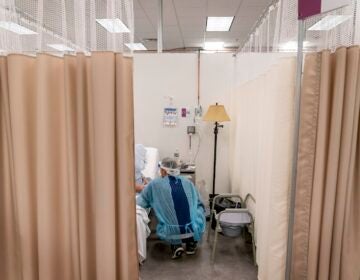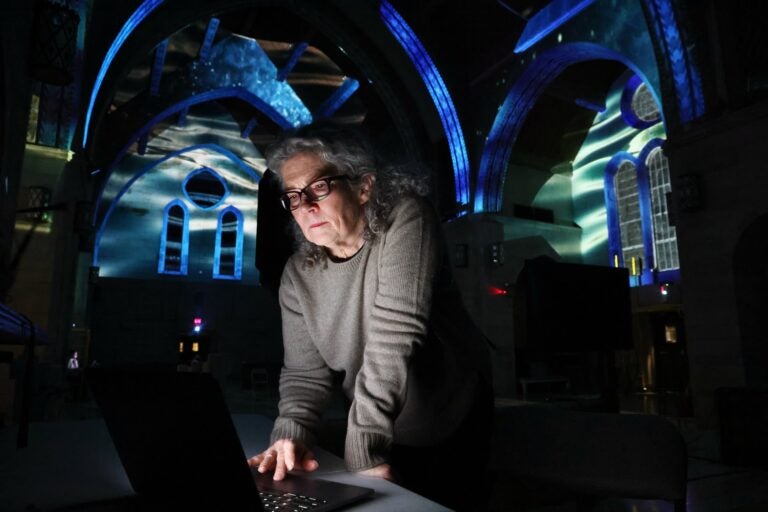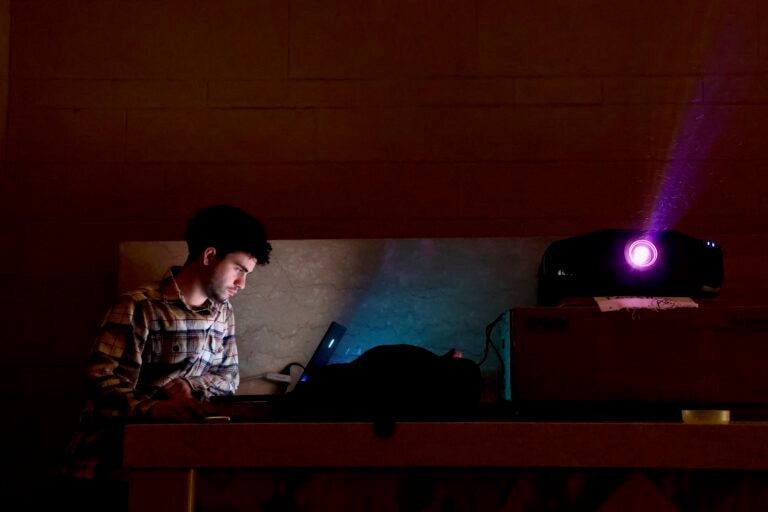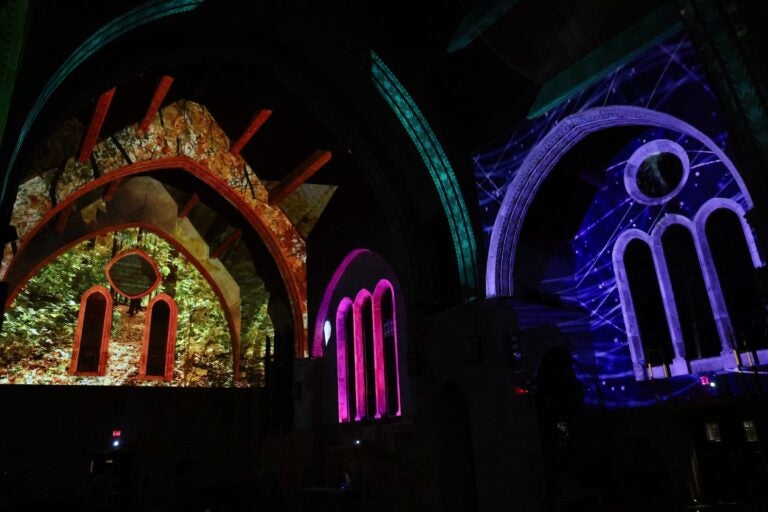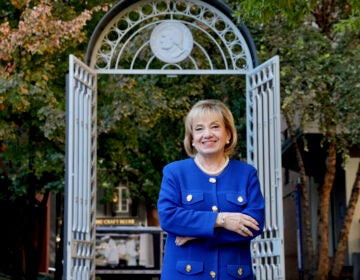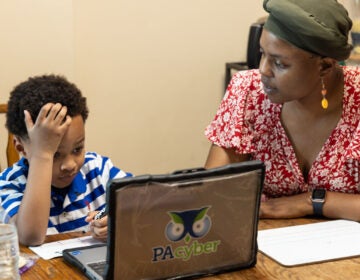Jefferson University researchers are illuminating a chapel to research the healing power of light
Bitmapped video projections in Ravenhill Chapel are experiments in the healing powers of light.
Listen 1:49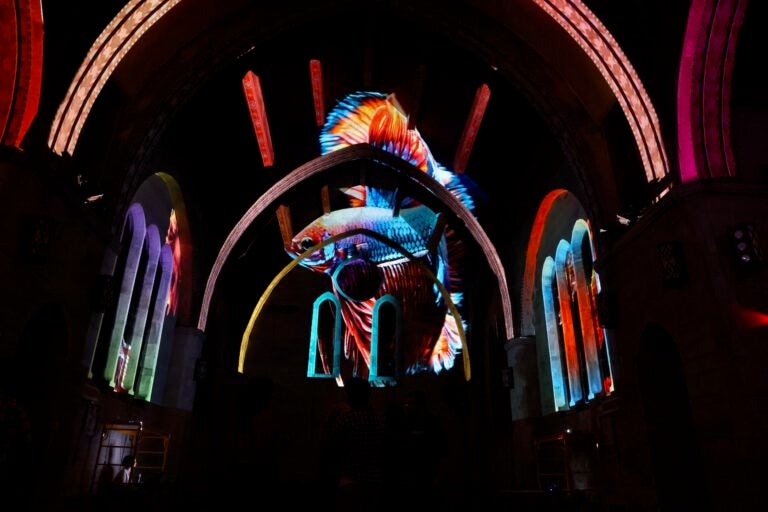
A fish swims through the vault of Ravenhill Chapel at Thomas Jefferson University's East Falls Campus. (Emma Lee/WHYY)
From Philly and the Pa. suburbs to South Jersey and Delaware, what would you like WHYY News to cover? Let us know!
Beginning this week, the stone chapel at the Thomas Jefferson University campus in East Falls will light up with exploding confetti, autumnal forests and schools of swimming koi.
On select days for the next two weeks, the vaulted ceiling of the Ravenhill Chapel will act as a screen for digitally bitmapped video projections, allowing the designers to place different kinds of imagery precisely onto specific architectural elements. The stone window frames can be one color, the stained-glass window shines with another. The barrels of the vaults will be bathed in a fog-covered lake or an oozing lava lamp.
The project is an experiment. Its six designers are Jefferson students from the “Lighting as Public Access” course taught by Lyn Godley, a light artist and professor of industrial design. The students are working with researchers at nearby St. Joseph’s University and Jefferson’s Center for Autism and Neurodiversity, who are studying environmental effects on people with autism.
The project inquires: Can immersive art environments have an impact on medical and neurological conditions; and, if so, how?
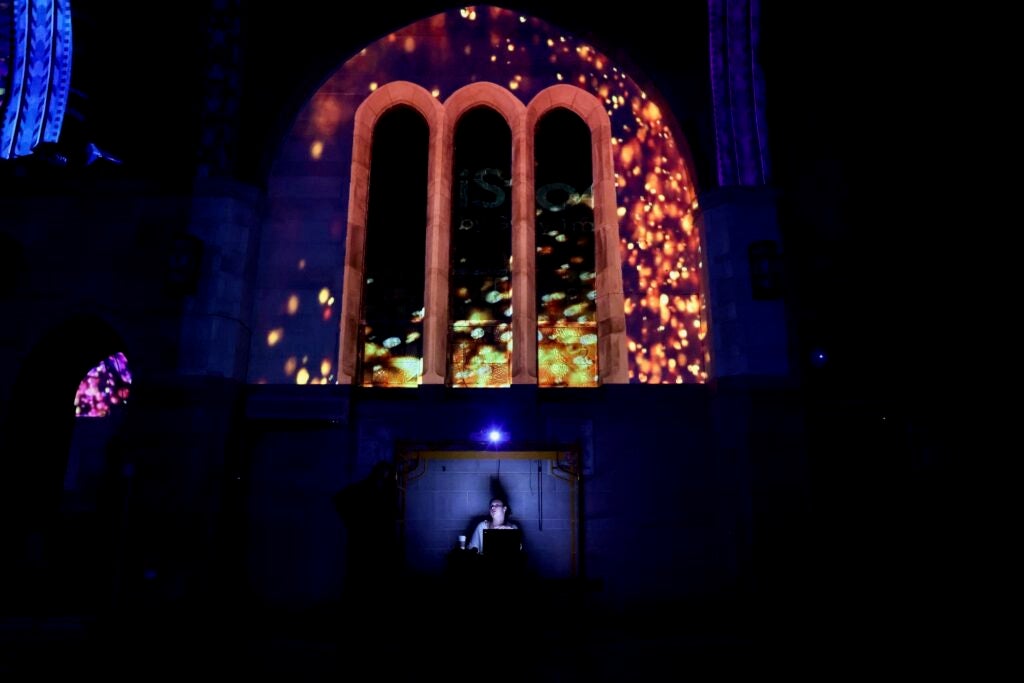
Participants who experience the immersive light environment will be asked to complete a brief survey about specific feelings they may or may not have had. Godley is doing outreach to local autism support organizations to encourage visitors who are on the spectrum.
“Is it calming? Is it making them excited? Does it make them feel inspired? Does it help them regulate their bodies?” said Wendy J. Ross, the director of Jefferson’s Center for Autism and Neurodiversity. “Would it be a good option to have similar types of experiences in other places, so that people could take a break or have an escape?”
Godley said it is unusual for designers to work directly with medical researchers, particularly at the academic level.
“What typically happens is that design students design things, and they may design it with the intent that it would be healing in some way, but they never study whether that actually happens,” Godley said. “Researchers study what’s already out there but they’re not coming back with the information and giving it to the designers. The areas of research and design in academics, and even professional practice, is very siloed.”
This is the second time Godley’s class and Ross collaborated to design an environment with the autism spectrum in mind. Last spring, they took over Ravenhill’s Chapel with bitmapped video, running a 20-minute program of animated nature imagery and monitored the effect on viewers.

“We had younger kids that were non-speaking that tended to be dysregulated,” Ross said, meaning participants had difficulty controlling their bodies and voices, sometimes sounding like they were screaming. “They came in and their bodies immediately calmed, and they looked around. You could also see their moms calm.”
Godley said the results exceeded her expectations.
“We were hoping that the results would say that it calmed the viewers down,” she said. “What we got back was that there was a significant increase in nine positive emotions, and a significant decrease in 12 negative emotions, which is much bigger than we were hoping for.”
These experiments will benefit everyone, Godley said.
“Realistically, if you are doing something that helps the neurodiverse, you’re helping everybody,” she said.
Godley expanded the current iteration of the project to include two visual programs: a seven-minute sequence of nature imagery, followed by an abstract sequence. Researchers want to compare the effects of the two programs.
Studies are mixed when it comes to the health benefits of abstract art. While some researchers say abstract art engages the viewer more deeply because subjects have to work to decipher it, others say abstract art can be too confusing and trigger low-level anxiety.
Isaac Pelligrino wanted to take Godley’s class after seeing last spring’s installation. He is a third-year industrial design student who, when not bitmapping video on the church ceiling, is working on making a better vegetable peeler for another class.
He said this project has broadened his sense of the field he wants to enter.
“I feel often, as an industrial designer, we can get trapped in designing an item for a very specific goal,” Pellegrino said. “This makes you step back and realize that we shouldn’t just design for a product or for a person. We should design for an entire experience.”
A research paper that resulted from last spring’s installation is still forthcoming, and another is expected from the current installation. Ross hopes that, ultimately, this kind of research can change federal and state regulations.
“When you think about the Americans with Disabilities Act, the laws are very, very clear for physical disabilities,” she said. “Like, you have to have a ramp and it has to be a certain height, a certain incline. “There are no such guidelines for the neurodivergent population. I feel like there should be.”
The light installation at Ravenhill Chapel, on Thomas Jefferson University’s East Falls campus, is open Nov. 4, 6, 11, 12 and 13, from 6:30 – 9 p.m.

Get daily updates from WHYY News!
WHYY is your source for fact-based, in-depth journalism and information. As a nonprofit organization, we rely on financial support from readers like you. Please give today.



